
Unfortunately, there are lots of things that can go wrong when keeping fish. Many of the costliest problems are diseases.
Fungal diseases are some of the most common examples that you might encounter. Anyone could experience a fungal outbreak in their tank, from an outright beginner to an experienced aquarist.
It is important to learn about all diseases, so you know how to treat them, and possibly prevent them. This will give your fish the best chance at survival if they were to become ill.
There are many varieties of fish fungus, each with their own causes, symptoms and treatments. This can make it very confusing when you think you’ve spotted disease in your aquarium.
We have put together a detailed guide about fungus. We cover everything you might need to know, including what it actually is, causes of fungal disease, types of disease and their treatment, and much more…
What is a Fungus?
Fungi are a large group of organisms. Perhaps the most well known are yeasts, molds, and mushrooms.
They are often mistaken for plants, but they are a completely separate group. In fact, fungi are their own kingdom in taxonomic classifications.
Fungi do not photosynthesize like plants; they consume food by absorbing dissolved molecules. They secrete digestive enzymes to do this.
Most are incredibly small; some are even single-celled. The three major groups are multicellular filamentous molds, macroscopic filamentous fungi (mushrooms), and single-celled microscopic yeasts.
The subdivisions of fungi are primarily based on their life cycles, structure, and type of spores. Spores are a reproductive unit that fungi use to spread into new areas.
There are around 120,000 fungal species, but their biodiversity is poorly understood. Some scientists estimate that there could be up to 3.8 million species.
Many species are very resilient, which allows them to live in extreme habitats that are usually barren. This includes deserts, deep sea, and areas with high levels of salt or ionizing radiation.
Most species are terrestrial, but some spend their whole life in water, or at least part of their lives. These are the fungi that you might encounter as an aquarist.
It’s most common for species to grow as structures called hyphae, which are string-like and can reach a few inches long. New hyphae grow from existing hyphae to create a branching effect.
This structure maximizes the surface area to volume ratio of the organism.
Fungi play a vital role in natural ecosystems. They are usually the primary decomposers in a food web. They break down organic matter, which is a key part of most nutrient cycles.
However, they can cause health problems for your fish in an aquarium. It’s important to understand this kingdom of organisms so you can help your fish if they ever suffer from fungal diseases.
Causes of Fungal Diseases
Potentially harmful fungal spores are constantly present in aquariums, but they usually exist unnoticed because they aren’t producing any harmful effects.
There are two main ways that these fungi could become a problem: poor water quality or unhealthy fish.
Low-water quality makes it easy for fungal spores to colonize quickly. Poor conditions in your tank make it a breeding ground for all pathogens though, not just fungi. This is one reason why it is vital that you maintain a healthy environment for your fish.
An unhealthy fish is at greater risk of developing a fungal infection due to having a weakened immune system. This is why fungal diseases tend to be secondary to another health problem.
Even a stressed fish will be less able to fight off disease.
Individuals with open wounds are the most likely to be afflicted. Physical wounds typically occur due to fighting, but they can also result from handling in a net, parasitic infections, or ulceration from bacterial infections.
Though some fungal species will always be present in your aquarium, other species could be added when you introduce new fish or secondhand equipment.
This makes quarantining a useful prevention method, which we’ll discuss later.
Common Fungal Diseases
Aquarium pathogens come in many forms, but fungal diseases are some of the most prevalent.
There are lots of different kinds that will present in your fish differently. Some will only affect certain species, but others can be a problem for virtually all fish.
Regularly take the time to watch your fish. Look out for any signs that could indicate disease. The sooner you find the disease, the quicker you can act, and the greater the chance of survival for your fish.
Below we describe some of the most common fungal diseases that aquarists might have to deal with.
Cotton-Wool Disease (Saprolegniasis)
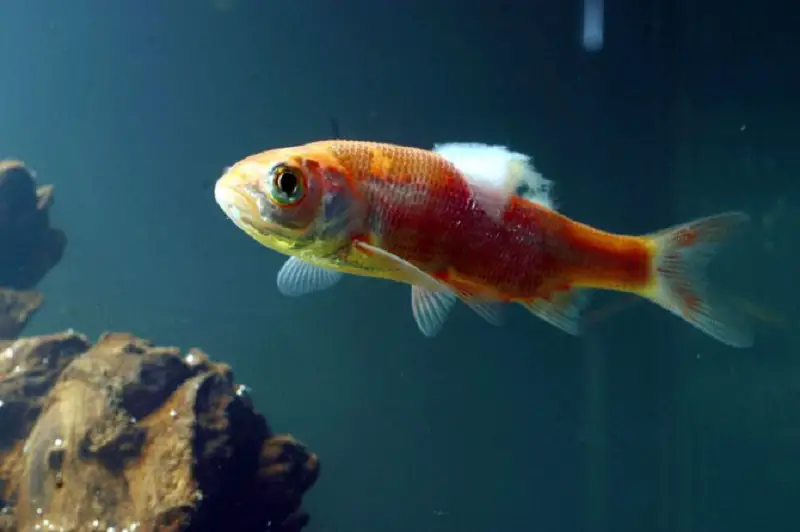
This is perhaps the most common fungal disease in the aquarium industry, particularly in fresh or brackish water.
Cotton-wool disease is caused by fungi of the genus Saprolegnia (a water mold), hence the disease is known as Saprolegniasis.
This disease is quite easily identified. It presents as grey or white patches along the skin of a fish or around the gills. The patches have a fluffy appearance.
These lesions start as small, localized infections, but the fungus can spread rapidly across the body, increasing the severity of the illness. The lesions do not penetrate deeply into the tissue of the fish though.
As the infection progresses, the color of the lesions change. The white coloration gradually turns to red, brown or green. Depending on the severity of the disease, this could make the whole fish appear a different color.
To officially diagnose the problem, the fluffy patches must be scraped off and examined under a microscope. This shows off the hyphae of the Saprolegnia.
This is unnecessary though because the symptoms are quite recognizable and identifying the species shouldn’t affect treatment.
Most instances of cotton-wool disease are as a secondary infection to a physical wound that breaks the skin, which allows the pathogen to enter.
However, an overcrowded tank and poor water conditions can increase the chances of Saprolegniasis being a primary infection.
This fungus can function through a large temperature range (32-95°F), which is one reason why it is so prevalent. Its ideal conditions are 59-86°F.
Often the term ‘cotton-wool disease’ is generalized to include all common fungal infections that affect the skin or gills because they present in a similar way, with fluffy lesions.
Achyla fungus can cause these similar symptoms.
Treatment can be done by using salt baths, but there are antifungal medications that can be purchased from stores.
Gill Rot (Branchiomycosis)
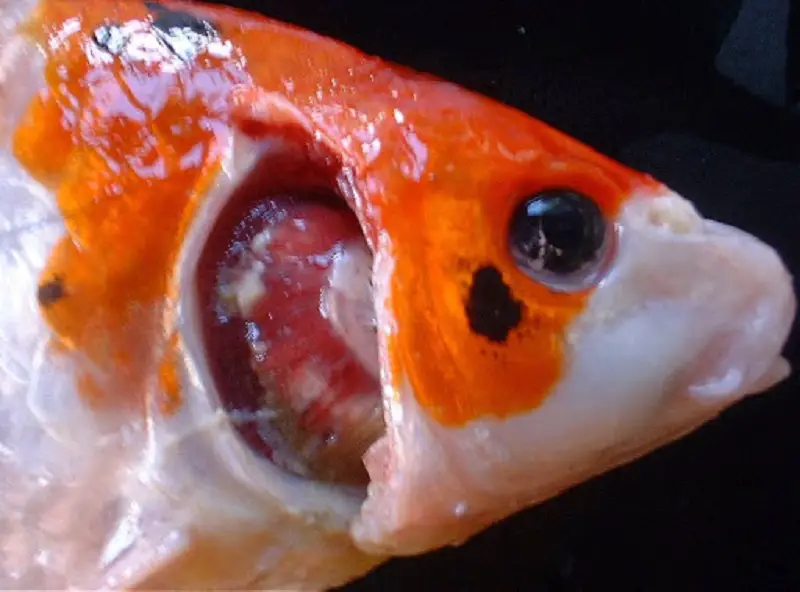
This disease is much less common than cotton-wool disease, but it can occasionally be seen in aquaria.
It is caused by species in the genus Branchiomyces, specifically, Branchiomyces sanguinis and Branchiomyces demigrans which infect carps and pike/tench respectively.
Obviously, carps, pike, and tench aren’t kept in home aquariums, which is why gill rot is most prevalent in European fisheries.
The disease produces mucus around the gills, making it difficult for the fish to respire. Infected fish might be seen heading to the surface and trying to gulp air.
The gills will gradually rot and decay, possibly disappearing completely, which is fatal. If tissue breaks off, it can spread fungal spores to other fish.
Gill rot can be deadly if not treated quickly, and treatment is difficult, so it’s best to try and prevent contact with this fungus in the first place.
To reiterate, Branchiomycosis is very uncommon in an aquarium though.
Ichthyosporidium
Ichthyosporidium is a fungus that targets the internal organs of a fish, before spreading externally.
Its primary focus is the liver and kidneys, but as the infection progresses it can spread virtually anywhere.
Once the fungus takes hold, the fish will become sluggish and lose balance. Then they will show hollow bellies before eventually developing external cysts or sores.
By the time the disease presents externally, it is probably untreatable, and the fish will likely die. Therefore, it is important to look out for the behavioral symptoms so the disease can be caught before it’s too late.
Treatment usually involves adding a 1% solution of phenoxyethanol or chloromycetin to food, but these chemicals could put your fish further at risk.
Trying to treat this disease is usually ineffective, so the safest practice is to remove the infected fish before the fungus can spread to others.
Exophiala sp.
There are two species in the genus Exophiala that cause issues: Exophiala salmonis and Exophiala psychrophila. These fungi have branched hyphae that are irregular in width.
They are a further two examples of species that attack internally, focusing on the kidneys, liver and spleen.
Eventually, round yellow or white granulomas present on these organs and the posterior kidney enlarges. Fish will also be darker in color, become lethargic, and swim abnormally.
Less is known about this disease compared to others, but it is also less common.
Egg Fungus
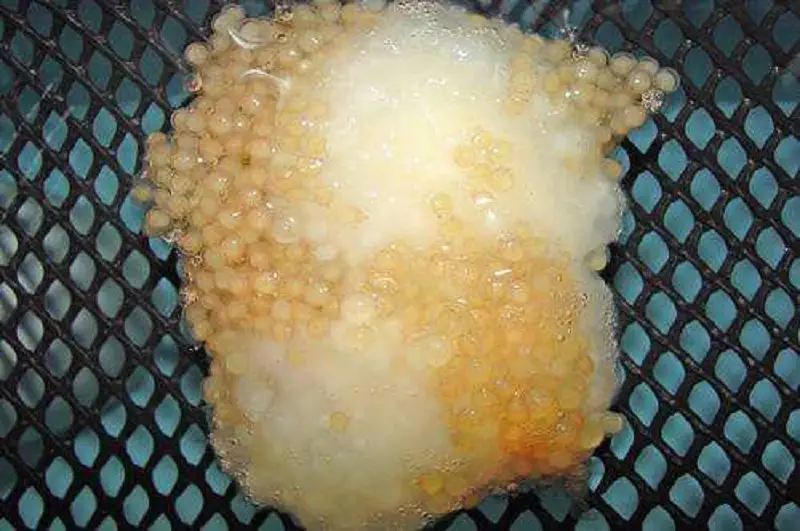
Fish eggs are at risk of fungal infections just like the actual fish. You need to be wary of fungal diseases if you have a breeding tank, or if any of your fish are actively breeding in your main aquarium.
The main culprits that might target eggs are Saprolegnia and Achyla. These cause white fluffy patches on the eggs, just like they would on the adults (cotton-wool disease).
Damaged or infertile eggs are the most at risk. Once the fungus has affected these, it can more easily spread to healthy ones.
Many egg-laying species of fish take care of their eggs once placed in the tank; part of this involves separating the diseased eggs to protect the rest. This could be saving you a job.
You might have to intervene if the parents abandon their eggs. Look out for infected eggs and remove them with a pipette, needle, or forceps. Just get rid of them, they are practically untreatable.
Treatment
We have mentioned a few ways to deal with specific diseases, but there are a few ways to increase your chances of success.
Spend a moment each day watching your fish and look for the common signs of fungal disease. Doing this regularly will help you to spot the problem early.
The sooner you sport the disease, the quicker you can treat it, which gives the treatment a greater chance of success.
You are probably watching your fish every day anyway (it’s likely why you got them in the first place) so this shouldn’t add too much time to your daily routine.
If you only see the disease on one of your fish, separate it as soon as possible, if you can. Treat it in isolation to reduce the likelihood that the fungus will spread to other fish.
Antifungal medications are usually the recommended solutions to many fungal diseases, such as cotton-wool disease. Often treatments are antibacterial as well as being antifungal.
Some fungi require species-specific treatments, so always research the suspected disease thoroughly before trying to eradicate it.
Different treatments can take varying amounts of time to be effective. Some can be tough to attain; you might even need to visit a veterinarian.
Ideally, you don’t want to ever encounter fungal infections, so preventing them should be a top priority.
Prevention
There is no guarantee that any fish will be able to survive a fungal disease, even with treatment. There are a few things you can do to reduce the chance of an outbreak in your fish tank.
We have already mentioned that an unhealthy environment allows pathogens to thrive, they do very well in poor conditions. If you maintain your aquarium well, it’ll be much harder for fungi to infect your fish.
You need to know how to clean your tank. This involves performing partial water changes regularly and wiping away excess algae.
Use a water testing kit each week. This will help you to keep track of the water chemistry. If the parameters aren’t how they should be, you can fix them before your fish fall ill.
Pathogens like fungi can enter an aquarium whenever you introduce new fish or secondhand equipment to your tank. Quarantining can help to prevent this.
By keeping new fish in a separate tank for a while, you can observe them over time to check for signs of disease. They can later be added to your main tank once you’re confident that they’re disease-free.
When purchasing new fish from a store, check the stock for signs of disease. If you observe any symptoms, shop elsewhere.
Summary
Fungi are an extremely large and diverse group of organisms. They play a crucial part in natural ecosystems, particularly their role in nutrient cycling.
It’s a different story in an aquarium though. They are a nuisance. They can suddenly spread rapidly throughout the tank, causing illness that could lead to death.
Though that sounds bleak, there’s plenty that you can do to protect your fish.
Prevention is the first thing you can do by maintaining the ideal conditions for your fish. Plan for the worst, but sometimes fish fungus is unavoidable.
There are lots of different fungal diseases. If you think your fish has one, research it thoroughly. Most common diseases have treatments that are easy to use.
For a treatment to be most effective, you need to spot the problem early, so keeping a close eye on your fish is one of the best things you can do.
By following the advice in this article, you’ll give your fish the best chance at survival.
Have you had a problem with fish fungus before? Let us know what happened in the comments below…




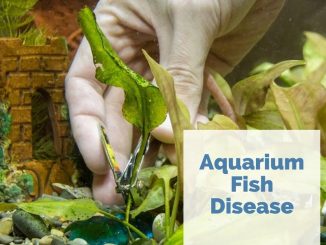
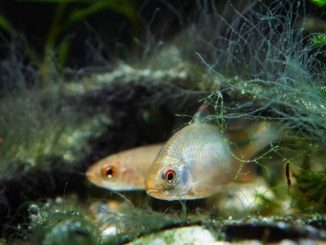
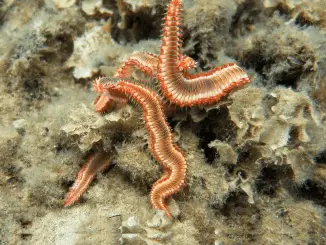
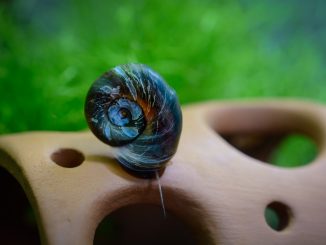
Be the first to comment